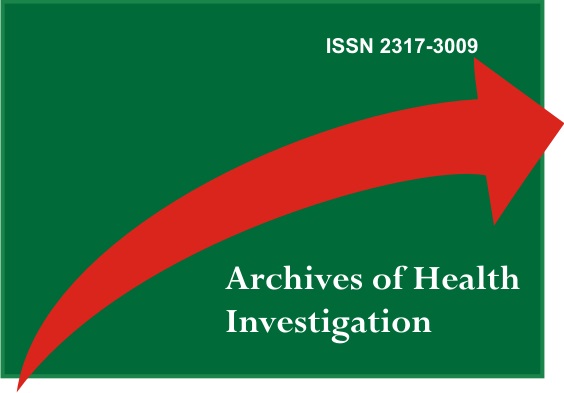Mandibular angle steel wire osteosynthesis and maxillo-mandibular blocking: case report
DOI:
https://doi.org/10.21270/archi.v10i5.5183Keywords:
Fractures, Bone, Mandible, Fracture FixationAbstract
The mandible is one of the bones most affected by facial trauma due to its anterior projection favoring the involvement of fractures. The location of the fractures is related to the anatomical areas of resistance and fragility where the force of the impact will be distributed. The treatment is based on the reduction and fixation of bone fragments, for this there are several techniques described in the literature, among them, the combination of intermaxillary fixation (FIM) and osteosynthesis with steel wire. The objective of this work is to report a clinical case of a patient with a mandible angle fracture, submitted to osteosynthesis with steel wire and FIM. Case report: Patient, 24 years old, male, attended the Hospital Maria Aparecida Pedrossian with a history of falling from a bicycle for fifteen days with trauma in the region of the left jaw, with difficulty in mouth opening, pain, presenting an angle fracture on tomography. of the jaw on the left side. In view of the clinical and tomographic examination, FIM and surgical treatment under general anesthesia for osteosynthesis with steel wire were chosen as a therapeutic approach, which proved to be an alternative technique to rigid internal fixation with satisfactory results.
Downloads
References
Ravikumar C, Bhoj M. Evaluation of postoperative complications of open reduction and internal fixation in the management of mandibular fractures: A retrospective study. Indian J Dent Res. 2019;30(1):94-6.
Morris C, Bebeau NP, Brockhoff H, Tandon R, Tiwana P. Mandibular fractures: An analysis of the epidemiology and patterns of injury in 4,143 fractures. J Oral Maxillofac Surg 2015;73(5):951.e1-951.e12.
Miloro M, Waiter PD, Larsen PE, Ghali GE. Princípios de cirurgia bucomaxilofacial de Peterson. 3.ed. São Paulo: Santos; 2016.
Motamedi MHK. An assessment of maxillofacial fractures: A 5-year study of 237 patients. J Oral Maxillofac Surg. 2003;61(1):61-4.
Ellis E, Moos KF, El-Attar A. Ten years of mandibular fractures: An analysis of 2,137 cases. Oral Surgery, Oral Med Oral Pathol. 1985;59(2):120-29.
Hollier LH. Evidence-Based Medicine: Mandible Fractures. 2017;192-200.
Franck FC, Oliveira Júnior PA de, Vitale M, Pino SD, Dias FJN. Meios de fixação mais utilizados em fraturas de ângulo mandibular. 2014;2(1):25-32.
Ellis E. Management of fractures through the angle of the mandible. Oral Maxillofac Surg Clin North Am. 2009;21(2):163-74.
Chen CL, Zenga J, Ruchin Patel, Branham G. Complications and Reoperations in Mandibular Angle Fractures. JAMA Facial Plast Surg. 2018;20(3):238-43.
Cillo JE, Ellis E. Management of bilateral mandibular angle fractures with combined rigid and nonrigid fixation. J Oral Maxillofac Surg. 2014;72(1):106-11.
Kreutziger KL. Surgical anatomy and surgical incisions. Oral Surg. 1984;58(6):637-46.
Mendonça JCG De, Quadros DC De, Jardim-Gaetti EC, Santos CM Dos, Masocatto DC, Oliveira MM, et al. Acesso extraoral para ostessíntese de fratura de ângulo mandibular. Arch Heal Invest. 2015;4(6):9-14.
Erich JB. Treatment of Fractures of the Upper Jaw. J Am Dent Assoc. 1942;29(5):783–93.
Kirk D, Whitney J, Shafer D, Song L. Tight Placement of Erich Arch Bar while Avoiding Wire Fatigue Failure. J Oral Maxillofac Surg. 2016;74(3):562-68.
Koshy JC, Feldman EM, Chike-Obi CJ, Bullocks JM. Pearls of mandibular trauma management. Semin Plast Surg. 2010;24(4):357-74.
Ferreira AGM, Weismann R, Heitz C, Oliveira MG de, Woitchunas GFP. Três métodos de bloqueio maxilomandibular para o tratamento das fraturas mandibulares. RFO UPF. 2004;68-72.


